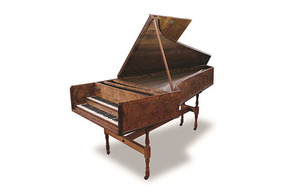Unique 18th century harpsichord at risk of export
A unique 18th century harpsichord is at risk of being exported from the UK unless a buyer can be found.

harpsichord
Joseph Mahoon’s ‘double-manual harpsichord’, built in 1738, has been blocked from export by Michael Ellis, Minister for Arts, Heritage and Tourism, to provide an opportunity to keep it in the country.
The harpsichord is the only one of its type now known to exist, and one of only two surviving instruments from this decade. It was made during a significant musical decade in the UK, in which London was at the forefront of instrument making among the major cities of Europe. Harpsichords were known to be the preserve of the rich due to the cost of making them and were high status instruments.
Exeter-born Mahoon became a renowned spinet and harpsichord maker, and was appointed as ‘Harpsichord Maker to His Majestie’, King George II, in 1729. He died in 1773.
Michael Ellis, Minister for Arts, Heritage and Tourism, said:
Surviving instruments from this period are crucial in helping us to understand musical and cultural life in 18th century Britain, particularly as there was no way of recording sound.
There is so much we can learn from this instrument’s history as well as the social context surrounding it, so it is right that we do all we can to preserve this valuable item for the nation.
While Mahoon was estimated to have been active as a harpsichord maker for more than 40 years, only two harpsichords and about a dozen spinets bearing his name have survived. The only surviving British harpsichords dated between 1730 and 1739 were those by Mahoon. This, the only surviving double manual harpsichord, is therefore unique and of outstanding significance.
Until recently, the item had been out of the UK for prolonged exhibits at the Germanisches National Museum in Nuremberg and at the Stadtmuseum in Munich.
The decision to defer the export licence follows a recommendation by the Reviewing Committee on the Export of Works of Art and Objects of Cultural Interest, administered by The Arts Council. They made their recommendation on the grounds that the item is closely connected with British history and national life, and is of outstanding significance for the study of music, musical instrument making and the history of performance.
Upon observation of the harpsichord, the Committee also noted that a list of mechanical and technical instructions for the player of the harpsichord was pasted upon the case of the instrument, leading to speculation that the instrument may have been used for public performance by a variety of players.
Reviewing Committee on the Export of Works of Art and Objects of Cultural Interest member Christopher Rowell said:
This double-manual harpsichord by Joseph Mahoon is a remarkable survival. As well as its significance in the history of British keyboard instrument making, it is beautiful in its own right.
Mahoon was well-known for such luxurious harpsichords to the extent that the famous print by his contemporary, William Hogarth, in ‘The Rake’s Progress’ series, depicts Handel playing a harpsichord by Mahoon, while accompanying the Bolognese castrato singer, Carlo Farinelli. Given that this may have been a concert instrument it is not impossible that the great composer may have performed on it. This is a considerable rarity redolent of a high point in British musical life.
The decision on the export licence application for the item will be deferred until 10 April 2019. This may be extended until 10 July 2019 if a serious intention to raise funds to purchase it is made at the recommended price of £85,560.
Organisations or individuals interested in purchasing the harpsichord should contact the RCEWA on 0845 300 6200.
ENDS
Notes to editors
Details of the item are as follows:
-
Double-manual harpsichord by Mahoon, London 1738
-
Matching offer: £85,560
-
The case of the instrument is in oak with walnut veneer and decorative crossbanding, while its keyboard has ivory naturals and ‘skunktail’ sharps of ebony/ivory/ebony. There are brass strapwork hinges, stop knobs and s-shaped lid hooks.
-
Measurements: Length 248cm, width 94cm, case height including lid 29.5cm.
The Reviewing Committee on the Export of Works of Art and Objects of Cultural Interest is an independent body, serviced by The Arts Council, which advises the Secretary of State for Digital, Culture, Media and Sport on whether a cultural object, intended for export, is of national importance under specified criteria.
The Arts Council champions, develops and invests in artistic and cultural experiences that enrich people’s lives. It supports a range of activities across the arts, museums and libraries – from theatre to digital art, reading to dance, music to literature, and crafts to collections. www.artscouncil.org.uk.
A Buyer’s Premium is an additional percentage charge on the hammer price, which is charged by the auctioneer to cover their expense